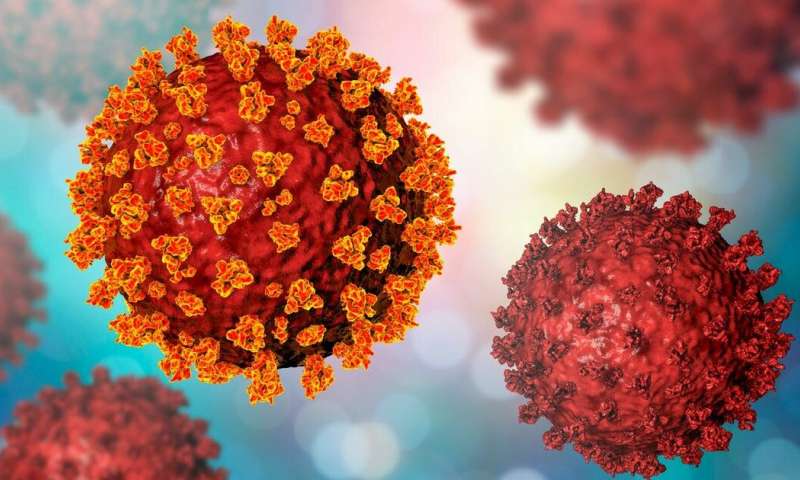Predicting the spread of COVID-19 using standard statistical models has its challenges, which is why two Iowa State University researchers developed a network-based approach to look at the impact of specific policies and vaccination strategies throughout the many stages of the pandemic.
Claus Kadelka, an assistant professor of mathematics; and Audrey McCombs, a graduate student in statistics, first started working on this issue in March. Kadelka says they found many of the models used “imperfect information to make predictions that were not accurate,” so he and McCombs took a different approach.
“Rather than try and predict something that really can’t be predicted given the uncertainty in the data, we developed an abstract model to compare different scenarios in a qualitative way to see which one gives us the best outcome, irrespective of the underlying uncertainty in all the key virus and disease parameters,” Kadelka said.
In a paper, published on medRxiv prior to peer review, the researchers used their social interaction network model to understand how homophily—the tendency to associate with people who share the same opinions and beliefs, in this case about COVID-19—affects the probability of an outbreak and the number of deaths. The model compares the probability of an outbreak for different levels of homophily and correlations among beliefs about vaccination and social distancing. Kadelka says they kept the same proportion of individuals with positive beliefs in all scenarios to provide an apples-to-apples comparison.
The model showed that the presence of homophily can have a strong influence on the probability of an outbreak. Homophily regarding vaccination implies there are clusters of vaccinated, but also clusters of unvaccinated individuals. The researchers found that such homophily in social interaction networks can lead to substantially more frequent outbreaks, especially in the presence of an effective vaccine.
“Standard models assume people’s social connections are random, which we know is not true,” McCombs said. “Modelling more realistic social patterns led to worse outbreaks and higher mortality than what standard models predict.”
They also found outbreaks occurred more frequently when there was a positive correlation between beliefs about vaccination and social distancing. If individuals who get the vaccine are the same people who are more likely to social distance, there is a percentage of the population not taking any protective measures, increasing the risk of an outbreak.
When there is a negative correlation—people get the vaccine, but don’t social distance or people social distance, but don’t get the vaccine—there are fewer outbreaks, because more people are following one of the mitigation strategies. The researchers say their model provides a more realistic assessment of how our interactions and increasing opinion polarization impact the spread of the virus.
Prioritizing vaccinations
Based on the findings, the researchers recommended policymakers consider local social distancing practices when prioritizing vaccination for high- or low-risk individuals. If those who are at high risk have substantially fewer contacts, prioritizing low-risk individuals for the vaccine reduced overall mortality compared to vaccinating high-risk individuals first. The researchers say the best vaccination strategy may differ from community to community depending on local adoption of risk mitigation strategies.
“High-risk individuals are generally older, have fewer contacts and while it’s difficult to measure, they are more likely to engage in distancing,” Kadelka said. “Low-risk people in their 20s and 30s have the most contacts and are less likely to distance. Depending on the relative contact rates, it may make sense to focus vaccination on this group in some communities.”
Social distancing, testing, hospital triaging
In a separate paper, published in the journal PLOS Computational Biology, Kadelka and McCombs first introduced their network-based model and demonstrated how COVID-19 policies—social distancing, testing and prioritizing care when hospitals reach capacity—interact with each other and enhance or undermine the effects.
Here are some of the key findings:
- Testing low-risk individuals more effectively reduced deaths than prioritizing high-risk individuals for testing. Low-risk individuals have more contacts and reducing their activity through testing slows the spread of disease.
- Reducing public or random encounters had a stronger effect on deaths than reducing personal contacts. This may be because public encounters allow the virus to spread quickly throughout a whole community, while personal contacts limit spread to a small subcommunity.
- The importance of testing and hospital triaging—when examining the combined effect—depends on the level of social distancing.
In the paper, the researchers wrote, “The goal of this study was not to predict the expected absolute number of COVID-19-related deaths; rather, the model is a tool that can be used, despite the uncertainty in key parameters, to compare the efficacy of various policies aimed at reducing mortality.”
Angie Hunt, Iowa State University


